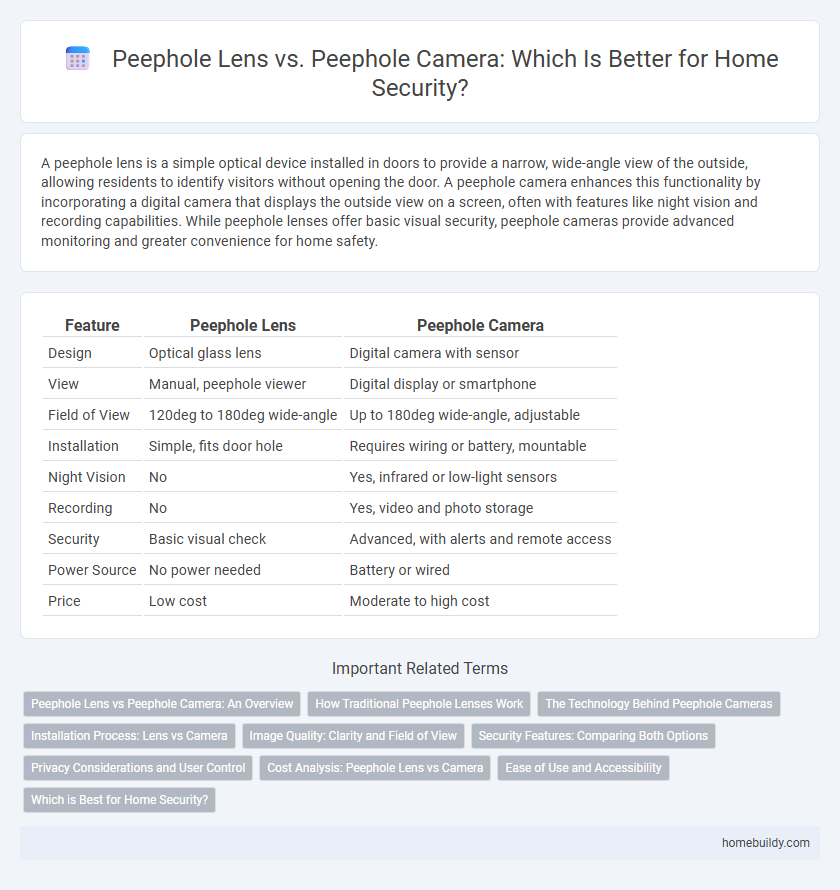A peephole lens is a simple optical device installed in doors to provide a narrow, wide-angle view of the outside, allowing residents to identify visitors without opening the door. A peephole camera enhances this functionality by incorporating a digital camera that displays the outside view on a screen, often with features like night vision and recording capabilities. While peephole lenses offer basic visual security, peephole cameras provide advanced monitoring and greater convenience for home safety.
Table of Comparison
| Feature | Peephole Lens | Peephole Camera |
|---|---|---|
| Design | Optical glass lens | Digital camera with sensor |
| View | Manual, peephole viewer | Digital display or smartphone |
| Field of View | 120deg to 180deg wide-angle | Up to 180deg wide-angle, adjustable |
| Installation | Simple, fits door hole | Requires wiring or battery, mountable |
| Night Vision | No | Yes, infrared or low-light sensors |
| Recording | No | Yes, video and photo storage |
| Security | Basic visual check | Advanced, with alerts and remote access |
| Power Source | No power needed | Battery or wired |
| Price | Low cost | Moderate to high cost |
Peephole Lens vs Peephole Camera: An Overview
Peephole lenses offer a simple, low-cost way to view outside a door with a wide-angle optical design that provides clear, distortion-free vision. Peephole cameras incorporate digital technology, enabling remote viewing via smartphones or monitors, and often include features like night vision and motion detection. Choosing between a peephole lens and a peephole camera depends on security needs, budget, and the desire for advanced surveillance capabilities.
How Traditional Peephole Lenses Work
Traditional peephole lenses function by using a fisheye lens to provide a wide-angle view of the outside, allowing residents to see visitors without opening the door. These lenses rely on optical distortion and refraction to create a panoramic image visible from inside the home. Unlike peephole cameras, which capture and display digital video, conventional peephole lenses offer a direct, real-time visual of the exterior through a small, circular glass lens.
The Technology Behind Peephole Cameras
Peephole cameras utilize digital imaging sensors and wireless technology to provide real-time video surveillance, offering enhanced clarity and remote access compared to traditional peephole lenses that rely on simple glass optics. These cameras often incorporate wide-angle lenses, IR night vision, and motion detection to improve security monitoring. Integration with smartphones through Wi-Fi or Bluetooth enables users to view and record footage remotely, significantly advancing the functionality beyond basic peephole lenses.
Installation Process: Lens vs Camera
Peephole lenses require simple installation by drilling a single hole in the door and inserting the lens, making the process quick and minimally invasive. Peephole cameras demand a more complex setup, involving wiring or battery placement, mounting the camera on the door, and sometimes connecting to a smartphone or home security system. While lenses provide immediate visual access through the door, cameras offer digital enhancements but require more technical installation effort.
Image Quality: Clarity and Field of View
Peephole cameras provide superior image quality with higher clarity and a wider field of view compared to traditional peephole lenses, enabling users to see clearer and more detailed visuals of visitors. Peephole lenses often offer limited visibility, typically around 160 degrees, whereas peephole cameras can extend the field of view up to 180 degrees or more, reducing blind spots. Enhanced resolution and digital display features in peephole cameras improve overall security by delivering sharper, real-time images both day and night.
Security Features: Comparing Both Options
Peephole lenses offer a simple, mechanical means of identifying visitors with limited field of view and no digital data storage, making them less vulnerable to hacking. Peephole cameras enhance security by providing a wider viewing angle, real-time video streaming, and remote access through smartphone integration, enabling users to monitor entrances from anywhere. Advanced models include motion detection, night vision, and cloud recording, significantly improving threat detection and evidence collection compared to traditional peephole lenses.
Privacy Considerations and User Control
Peephole lenses offer enhanced privacy by allowing users to view visitors directly without transmitting or storing digital data, thereby minimizing risks of unauthorized access or hacking. Peephole cameras capture and sometimes stream video, increasing privacy concerns due to potential vulnerabilities in internet connectivity and data storage. User control with lenses is immediate and manual, whereas cameras often require managing app permissions, cloud storage, and firmware updates to maintain privacy.
Cost Analysis: Peephole Lens vs Camera
Peephole lenses typically cost between $5 and $20, making them the most affordable option for basic door security. Peephole cameras, however, range from $50 to $200 or more, reflecting their advanced features like video recording and remote viewing. The initial investment in a peephole camera is higher, but it provides enhanced security and convenience compared to the low-cost, simple function of a peephole lens.
Ease of Use and Accessibility
Peephole lenses offer straightforward installation and immediate access without requiring power or connectivity, making them highly accessible for all users. Peephole cameras provide enhanced features like remote viewing and video recording but often require smartphone integration and Wi-Fi setup, which may pose usability challenges for less tech-savvy individuals. The simplicity of peephole lenses ensures universal ease of use, while peephole cameras prioritize advanced functionality with a slightly steeper learning curve.
Which is Best for Home Security?
Peephole cameras offer enhanced home security by providing clear digital video feeds and remote viewing capabilities, unlike traditional peephole lenses that only allow a limited field of view through a small glass lens. Peephole lenses are simple, cost-effective, and require no power, but their manual nature limits situational awareness and nighttime visibility. For comprehensive security needs, peephole cameras with features like motion detection, recording functions, and smartphone connectivity deliver superior monitoring and threat detection.
Peephole Lens vs Peephole Camera Infographic

 homebuildy.com
homebuildy.com